Binary FSK modulates digital data using two distinct frequencies, offering simplicity and robustness in noise, while M-ary FSK expands this concept by employing multiple frequencies, increasing data rates and spectral efficiency at the cost of higher complexity. Explore the rest of the article to understand how these modulation techniques impact your communication system's performance.
Comparison Table
| Feature | Binary FSK (BFSK) | M-ary FSK (MFSK) |
|---|---|---|
| Number of Frequencies | 2 | M (M > 2) |
| Transmission Rate | Lower | Higher (More bits per symbol) |
| Bandwidth Requirement | Smaller | Larger (Increases with M) |
| Complexity | Low | Higher (More complex modulation/demodulation) |
| Error Performance | Better at low M | Improves spectral efficiency, slight performance degradation |
| Applications | Simple, low data rate systems | High data rate systems, spectral efficiency critical |
Introduction to Frequency Shift Keying (FSK)
Frequency Shift Keying (FSK) is a digital modulation technique where information is transmitted through discrete frequency changes of a carrier signal. Binary FSK uses two distinct frequencies to represent binary 0 and 1, making it simple and robust for low data rate communication. M-ary FSK extends this concept by employing multiple frequencies, enhancing data rates and spectral efficiency while requiring more complex receivers for accurate demodulation.
Basics of Binary FSK: Principles and Operation
Binary Frequency Shift Keying (FSK) operates by using two distinct frequencies to represent binary data, where one frequency corresponds to a binary '0' and the other to a binary '1'. This modulation technique is simple, efficient, and widely used in digital communication systems for its robustness against noise and ease of implementation. If you need a straightforward method to transmit digital signals reliably, understanding the principles of Binary FSK is essential before exploring M-ary FSK, which extends these concepts by using multiple frequencies to encode more bits per symbol.
Understanding M-ary FSK: Expanding the Modulation
M-ary Frequency Shift Keying (FSK) expands on binary FSK by using multiple frequency tones to represent more than two symbols, increasing data transmission rates. In M-ary FSK, each symbol corresponds to one of M distinct frequencies, allowing the encoding of \(\log_2(M)\) bits per symbol instead of just 1 bit in binary FSK. This modulation technique enhances spectral efficiency and is widely used in communication systems where increased bandwidth utilization and higher data throughput are critical.
Key Differences Between Binary FSK and M-ary FSK
Binary FSK (Frequency Shift Keying) uses two distinct frequencies to represent binary data (0 and 1), offering simplicity and robustness in noise environments, making it ideal for low data rate communications. M-ary FSK extends this concept by employing multiple frequencies (M > 2), increasing spectral efficiency and data rates by encoding more bits per symbol but requiring more complex receivers and higher bandwidth. The key differences lie in the trade-off between data throughput and system complexity, with binary FSK favoring simplicity and M-ary FSK targeting enhanced performance in bandwidth-constrained channels.
Spectral Efficiency: Binary FSK vs M-ary FSK
M-ary FSK offers higher spectral efficiency compared to binary FSK by encoding multiple bits per symbol, which reduces the bandwidth needed for transmitting the same data rate. Binary FSK transmits one bit per symbol, resulting in wider bandwidth use for a given bit rate. Enhancing Your system with M-ary FSK improves spectrum utilization, making it preferable for bandwidth-constrained communication channels.
Power Efficiency and Energy Consumption Comparison
Binary FSK offers higher power efficiency due to its simpler signal constellation, requiring less energy per bit compared to M-ary FSK, which uses multiple frequencies and increases complexity. M-ary FSK consumes more energy because it transmits more bits per symbol, leading to higher average power usage despite improved spectral efficiency. The trade-off between power efficiency and bandwidth utilization makes binary FSK more suitable for energy-constrained systems, while M-ary FSK benefits high-data-rate applications with relaxed power constraints.
Error Performance in Noisy Channels
Binary FSK typically exhibits better error performance in noisy channels compared to M-ary FSK due to its simpler signal constellations and larger Euclidean distances between symbols, which reduce symbol confusion. However, M-ary FSK offers higher data rates by transmitting multiple bits per symbol, though at the cost of increased error probabilities under the same noise conditions. Your choice between binary and M-ary FSK should balance the trade-off between error performance and spectral efficiency based on channel noise characteristics.
Complexity of Implementation and Hardware Requirements
Binary FSK simplifies implementation with lower hardware complexity, as it uses only two distinct frequencies requiring fewer oscillators and simpler demodulation circuits. M-ary FSK increases hardware requirements by accommodating multiple frequencies simultaneously, necessitating more complex oscillators, filters, and signal processing components to accurately distinguish among the different frequency signals. Your choice between binary and M-ary FSK affects the trade-off between hardware cost and spectral efficiency, with M-ary demanding more sophisticated and resource-intensive hardware.
Typical Applications of Binary FSK and M-ary FSK
Binary FSK is commonly used in low-data-rate communication systems like remote controls, caller ID, and basic telemetry due to its simplicity and robustness in noisy environments. M-ary FSK, offering higher spectral efficiency and data rates, is favored in advanced wireless communication systems such as satellite links, digital radio broadcasting (e.g., DAB), and military communication where bandwidth efficiency and error performance are critical. The choice between binary and M-ary FSK typically depends on application requirements for bandwidth, power, and complexity.
Choosing the Right FSK Scheme for Communication Systems
Binary FSK offers simplicity and robustness for low data rate applications, making it ideal for basic communication systems with limited bandwidth. M-ary FSK, with multiple frequency shifts, enhances spectral efficiency and data throughput, suitable for advanced systems requiring higher capacity and improved performance in noisy environments. Your choice depends on balancing system complexity, bandwidth availability, and the desired data rate to optimize communication effectiveness.
binary FSK vs M-ary FSK Infographic

 solderic.com
solderic.com